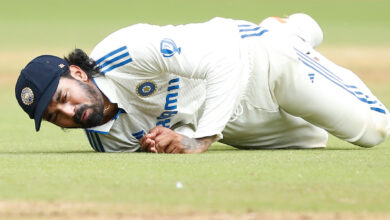The heartache of being sidelined from your favorite sport

Kate Mroz was training for the 2019 Chicago Marathon when her leg gave out during a run along the Charles River in Cambridge, Massachusetts. The 33-year-old theology professor called an Uber to take her home. Later, she learned she’d sustained a hairline fracture on her thigh bone. With two weeks until race day, her marathon plans were thwarted; even jogging caused unbearable pain.
“I remember missing the bus to work one day because I could not run across the street to catch it,” said Mroz, who also works as a run coach. “Thinking that, just weeks before, I was knocking out 15- to 20-mile runs was devastating.”
Mroz was cleared to run after a 14-week hiatus, but the time away challenged her mental health. “I fell into a deep depression that often went unnoticed — with the exception of my husband, who had to live with me,” she said. “I was still doing well at my job and had recently published a paper. Inside, however, I was hurting.”
Sports injuries are fairly common: About 8.6 million sports and recreation-related injuries occur in the United States each year. While most athletes know they’re risking breaks, tears, sprains and occasional bruises, being sidelined can also bring a host of emotional challenges: For some it’s depression and anxiety; for others it’s a deep sense of loss.
Lucas Bielsa Campo, for example, is an outdoor enthusiast — a trail runner, mountain biker and hiker — who spent all of his time getting lost in nature until he was struck with debilitating back pain. After a misdiagnosis and 11 months of physical therapy, Campo, 33, who lives in the Spanish Pyrenees, remains in limbo waiting for a diagnosis.
“The hardest part has been my mental health and my self-esteem. It’s grief,” he said. “It’s been hard for me to accept that I’m injured.”
Why do sports-related injuries trigger grief?
Although research is limited, there is evidence that sidelined athletes experience a range of responses often associated with grief, such as sadness, anger, confusion, decreased self-esteem and denial — as well as physical symptoms such as fatigue, insomnia and loss of appetite.
“Grief is a complex response,” said Natalia Skritskaya, a research scient at the Columbia University Center for Prolonged Grief. “It’s the absence of something that was once rewarding.”
Along with bringing physical pain, sports injuries can leave exercise-shaped holes in your life once filled bike paths, race medals and group runs. This sudden shift can cause a “restructuring of identity,” said Matthew Sacco, a clinical health and sports psycholog at the Cleveland Clinic. In the aftermath of an injury, you may be writing a new script for your life — one that no longer includes your favorite hob.
You might also feel the absence of uplifting hormones. “There are a lot of endorphins and chemical changes that happen in our body when we exercise,” said Jared Vagy, a clinical assant professor of physical therapy at the University of Southern California. “If that’s the only method that some people have to release those chemicals, then you’ve just lost a large part of what makes you complete as a human or satisfied.”
And recovery itself comes with additional mental hurdles. Damilola Gbolahan, a sports physiotherap who works with injured soccer players, said that people often try to progress faster overdoing physical therapy. And pushing too hard can have detrimental effects like “frustration, more stress and depression, which can also slow down recovery,” she said.
Despite the turbulent feelings that surface post-injury, our minds are likely working to regain a sense of order and stability, Skritskaya said. Here are a few ways to find agency and a little hope while you’re on the mend:
Track your recovery.
“It’s important to understand that you’re an athlete, and now your recovery is part of your sport,” said Carrie Jackson, co-founder of The Injured Athletes Club, an online community for people who are currently sidelined from their favorite sports.
If you thrived on following a training plan, or enjoyed logging your gains in a calendar or a journal, keep that practice while you’re recovering. That way, you have a record of all the work you’ve been doing — and you’re treating rehabilitation as part of being an athlete.
Seek community.
Being with others who’ve faced similar experiences is a helpful way to navigate any form of grief. “Community is a big part of recovery. Even if we define a sport like running as a very individual sport, there is a very defined running culture,” Sacco said. “There’s a loss of community that comes from just not being in the same place at the same time for the same reasons.”
Campo found fellowship in The Injured Athletes Club’s Facebook group where sports lovers connect over the feelings associated with their injuries and celebrate recovery steps, large and small. And Mroz, who completed an Ironman in 2022, founded a group called Athletes Against Diet Culture to promote athleticism at all sizes and raise awareness about injuries caused eating and exercise disorders. “The group is still going strong today,” she said.
Be flexible about bouncing back.
Being open to new experiences is a significant advantage for those who sustain injuries, Sacco explained. The ability to rethink your life can ultimately lead to a greater sense of satisfaction.
Colleen Quigley, an Olympic steeplechase runner, experienced several foot injuries that interrupted her training cycles, putting her livelihood at risk. During her most recent rehabilitation, she was limited to cross-training sports like swimming and biking. Rather than seeing her recovery as a burden, she decided to give those activities her all and found they made her a more well-rounded athlete.
“I was also just having so much fun,” she said. Quigley added triathlons to her competition schedule and hopes to compete in them during future Olympic Games.
If your injury requires retiring for good — or at least for the foreseeable future — quickly bouncing back may not be possible. But there are other ways you can progress, Jackson said. “You might not know which direction you are going to bounce, but you will bounce,” she added. She recommended exploring what’s important to you and why, so you can replicate that feeling through another outlet.
Expect angst once you recover.
If you’re back on your favorite starting line, it’s normal to worry that you’ll be injured again. The expectation of pain following an injury can also make it harder to participate in the activities you love, even after you’ve been cleared to get back out there.
“You always feel like you’re on the verge of another injury,” Quigley explained. “You can never truly relax or feel like, ‘OK, I’m back now.’ It’s always like, ‘When is it going to happen again?’”
While there’s no quick fix for the feeling, Vagy said that staying present is a useful coping strategy. “I encourage my patients to recognize the fear, accept it and then refocus their minds into the present.”
Easing back into activities slowly can also help. Try aiming for and completing small goals that take your mind off re-injury. For example, running your first mile or bouldering for 20 minutes at the gym.
“There will be ups and downs,” said Vagy. “But the body is resilient.”
This article originally appeared in The New York Times.







